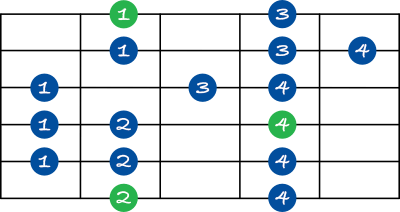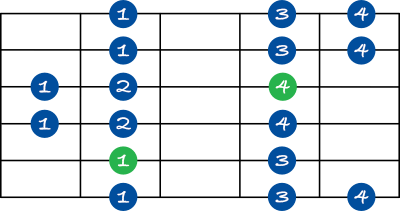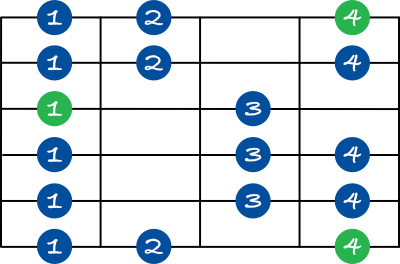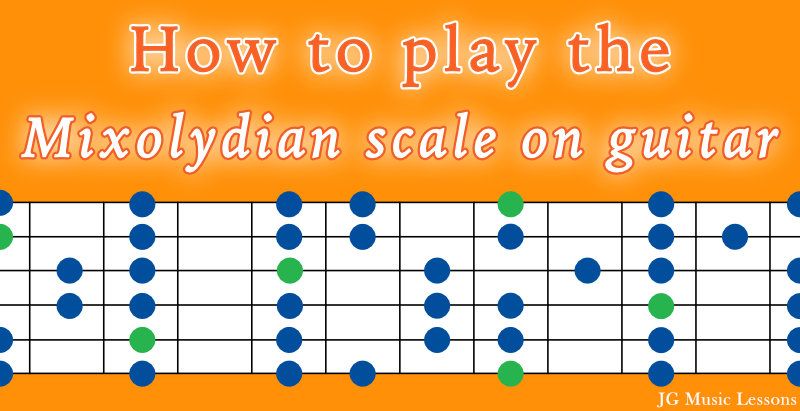The mixolydian scale is the fifth mode of the Major scale and is used across various music genres. It is one of the essential scales you would want to learn, especially for improvising on guitar.
This scale is very similar to Major scale but with a small twist by changing one of the notes which gives it its unique sound.
In this lesson, we’ll cover the music theory for the mixolydian scale, examples in different keys, learn the 5 scale shapes, and application examples. Grab your guitar and let’s get started!
Mixolydian scale formula
If you start and end on the 5th degree of the Major scale, you are playing a mixolydian scale. For example, a G mixolydian scale would have the notes G, A, B, C, D, E, and F (same notes in a C Major scale). In terms of scale degrees, the notes are root, 2, 3, 4, 5, 6, and flat 7.
If you notice, there is only one note difference between the mixolydian scale and the Major scale. The mixolydian scale has a flat 7th degree, while the Major scale has a natural 7th degree. For example:
- E mixolydian scale: E, F#, G#, A, B, C#, and D.
- E Major scale: E, F#, G#, A, B, C#, and D#.
We can also look at the mixolydian scale formula in terms of whole and half steps. The formula would be whole, whole, half, whole, whole, whole, and half step between the scale notes. See the image below.

You can also simply think of the parent scale that a mixolydian scale comes from by counting a perfect 4th interval above or 2.5 whole steps above. For example, C mixolydian would have the same notes as an F Major scale. Or A mixolydian would have the same notes as a D Major scale.
Mixolydian scale examples with tabs
Here are some different mixolydian scales in music notation with guitar tabs below. The numbers above the notes on the top staff indicated which fingers to use on your fretting hand. If needed, check out how to read guitar notation symbols.
The following examples show you how to play different scales in one octave but we’ll also cover how to play beyond one octave later in this lesson.
C mixolydian scale example

D mixolydian scale example

E mixolydian scale example

F mixolydian scale example

G mixolydian scale example

A mixolydian scale example

B mixolydian scale example

Mixolydian scales chart
The following chart shows you the notes for all mixolydian scales.
| Mixolydian scale | 1 | 2 | 3 | 4 | 5 | 6 | b7 |
|---|---|---|---|---|---|---|---|
| C mixolydian scale | C | D | E | F | G | A | Bb |
| D mixolydian scale | D | E | F# | G | A | B | C |
| E mixolydian scale | E | F# | G# | A | B | C# | D |
| F mixolydian scale | F | G | A | Bb | C | D | Eb |
| G mixolydian scale | G | A | B | C | D | E | F |
| A mixolydian scale | A | B | C# | D | E | F# | G |
| B mixolydian scale | B | C# | D# | E | F# | G# | A |
| Db mixolydian scale | Db | Eb | F | Gb | Ab | Bb | B |
| Eb mixolydian scale | Eb | F | G | Ab | Bb | C | Db |
| Gb mixolydian scale | Gb | Ab | Bb | B | Db | Eb | E |
| Ab mixolydian scale | Ab | Bb | C | Db | Eb | F | Gb |
| Bb mixolydian scale | Bb | C | D | Eb | F | G | Ab |
5 Mixolydian scale guitar shapes
The following section shows you the 5 mixolydian scale shapes throughout the guitar fretboard.
How to read the scale charts
For the charts below:
- The lowest horizontal line represents the thickest string (Low E). The top horizontal line represents the thinnest string (high E).
- The green circles represent the root note of the mixolydian scale and the blue notes are every scale note in between.
- The numbers inside the circles represent the suggested fingering to use on your fretting hand.
If needed, check out how to read guitar notation symbols.
Mixolydian scale shape 1

Mixolydian scale shape 2

Mixolydian scale shape 3

Mixolydian scale shape 4

Mixolydian scale shape 5

Mixolydian scale guitar application examples
The mixolydian scale works over the 5 chord in a Major progression and over dominant chords in general. You can also try it over Major chords to add a bluesy flavor to your playing. A great place to use it would be over a 12 bar blues.
Here are 5 application examples over different chords.
G mixolydian scale pattern – example 1
For the first application example, we are using a mixolydian scale pattern using an interval of thirds. The pattern starts on the 9th of the G7 chord and ends on the flat 7 scale degree.

You can also try this scale pattern starting on different degrees and in ascending motion.
E mixolydian scale pattern – example 2
For this example, we are using another mixolydian scale pattern using intervals of 6ths over an E 7 chord.

C mixolydian scale – example 3

A mixolydian scale – example 4
This application example combines the pentatonic scale with the mixolydian scale. This lick starts with the 5 notes of an A Major pentatonic scale.

D mixolydian scale pattern – example 5
For this last pattern, we are using diatonic triads to create this scale pattern. We are using the G Major scale notes over the D 7 chord. The pattern uses this scale note sequence for each triad: 3, 1, 3, 5 starting with D Major, then E minor, F# diminished, and so on.

For more improvisation ideas, check out how to play Dominant 7 arpeggios on guitar or 7 jazz and blues licks over a dominant chord.
Wrapping up
The mixolydian scale is an essential scale you want to learn for creating more interesting guitar solos, especially for styles such as jazz or blues. In short, all you need to do is lower the 7th degree of a Major scale to play a mixolydian scale.
I suggest memorizing all the shapes well and then working on how to make the scale sound musical. For some ideas on how to do this, check out this lesson on how to practice scales on guitar. You may also want to learn how make your melody lines sound jazzy.
You can also see an overview of the Major scale modes and their related emotions here or learn the specific scales below:
- Ionian scale (Major scale)
- Dorian scale
- Phrygian scale
- Lydian scale
- Aeolian scale (minor scale)
- Locrian scale
📘 Get the free guitar practice guide here!
All the best,
JG Music Lessons
Start Playing Better, Faster
with Pro Membership! ✨
Get the guidance, tools, and support that keep your progress on track:
🏁 Always know what to practice next. Access the full Guitar Learning Roadmap with lessons in sequence.
🎼 Play songs with confidence. Step-by-step lessons of popular, classical pieces and other styles.
📙 Save time and frustration. Clear PDFs and ebooks that save time so you can focus on playing.
🎟️ Get rewarded for consistency. 2 free downloads every month (a $240+ yearly value).
🎁 Keep costs low while you grow. 50% off all charts, tracks, and posters — up to 75% off bundles.
🚫 Stay focused. Ad-free environment keeps you in the zone.
💬 Get help when you need it. Direct member support to keep you on track.

